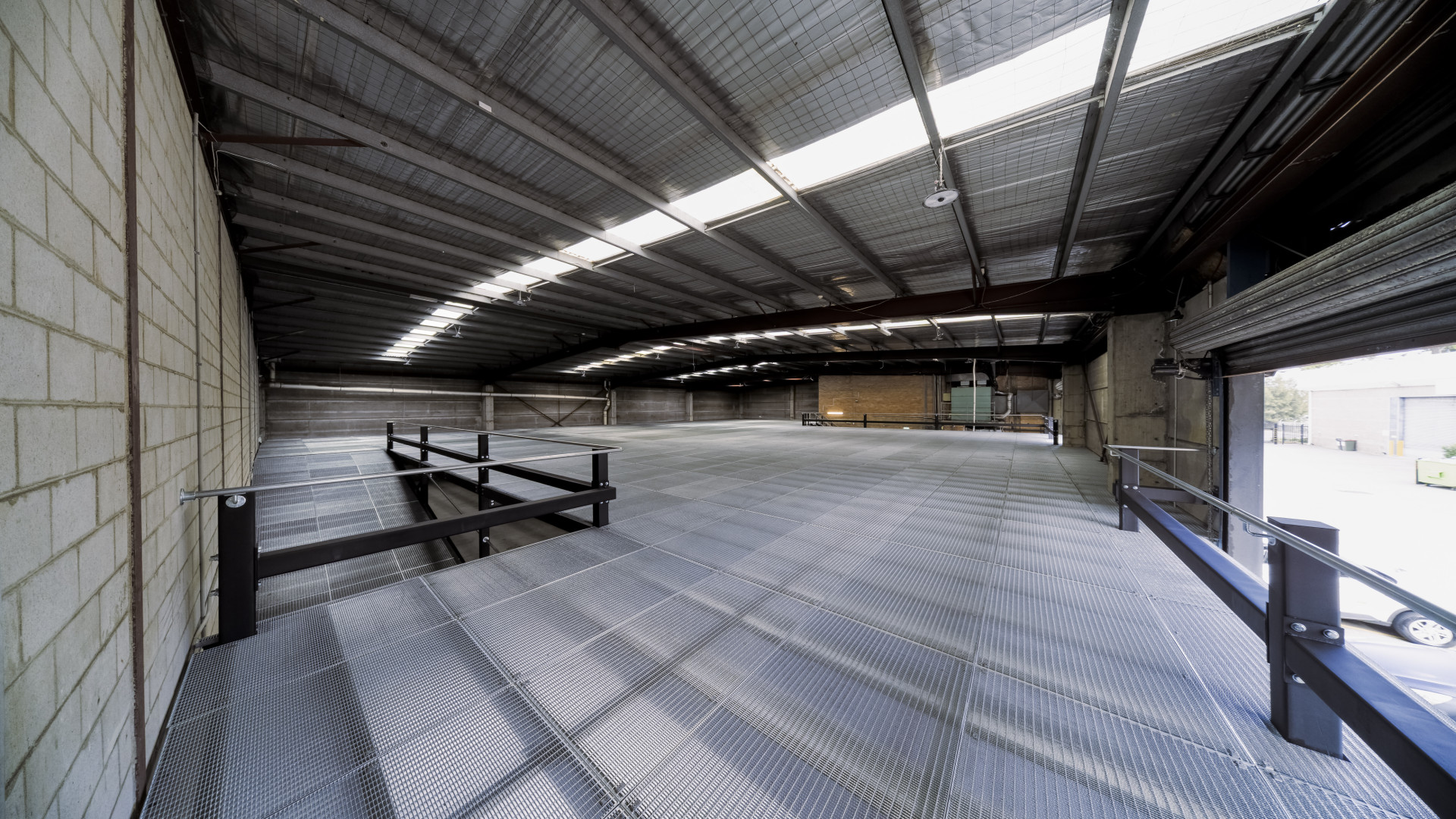The larger the surface area, the higher the storage capacity—it’s a simple formula. But what if there was a better way to achieve this? Mezzanine floors are semi-permanent platforms commonly installed between a warehouse’s ground level and its ceiling. In large industrial facilities, these intermediate structures offer a method to boost usable floor area without revamping the building’s footprint. As calls for high-capacity warehouse storage solutions grow, businesses look to manage bulging inventories, streamline workflows, and ramp up efficiency. One strategy that has proven both flexible and cost-effective is the mezzanine floor system.
Mezzanines tackle a variety of operational hurdles, from housing broad stock-keeping units (SKUs) to syncing with cutting-edge automation technologies. This article looks at the underlying engineering principles, major perks and real-world case studies of warehouse mezzanine floors specifically designed for large-scale mezzanine structures. Whether you oversee retail distribution, automotive warehousing, or e-commerce fulfillment, understanding how mezzanines can sharpen your storage game is vital to staying competitive.
Understanding large-scale mezzanine structures
Large-scale mezzanine structures are built to shoulder hefty loads and ongoing operational demands. Their knack for spanning vast areas depends on sound engineering concepts that put structural integrity in mezzanines first. A core consideration is load-bearing capacity, which must match the weight of stored items, handling gear and shifting loads caused by day-to-day foot traffic or operating machinery throughout a busy facility.
Material composition
Typically, mezzanines use materials like steel or reinforced aluminium. Steel delivers a load-bearing capacity, making it perfect for heavy-duty setups in manufacturing facilities or automotive warehouses. Reinforced aluminium, meanwhile, can form a lighter build well-suited to sites where quick assembly or layout tweaks are crucial. In every instance, careful design ensures the mezzanine stays stable over wide spans, even under heavy loads, meeting safety and efficiency benchmarks.
The ceiling’s the limit
Many industrial facilities already use lofty ceilings for racking, so a mezzanine stretching across broad floor areas can deftly convert vertical space into dynamic storage or work zones. With clever engineering and day-to-day planning, these multi-tier builds crucially become central to warehouse space optimisation, letting sites manage growing inventory demands without overburdening their current footprint.
Key benefits of mezzanines for high-capacity storage
Maximising vertical space
One standout advantage of mezzanines is their ability to harness vertical space. Traditional renovations usually involve lengthy council approvals, higher construction costs and disruption. By looking upwards, warehouses can install multi-tier storage solutions that effectively double or triple usable area. This approach is especially valuable in logistics and distribution centres, where busy turnaround of large SKU volumes demands accessible storage. Because mezzanine projects generally wrap up faster than major construction works, operations can continue with minimal downtime. It’s a straightforward way to leverage existing height for big gains in capacity.
Scalability and flexibility
Modular mezzanines give organisations a flexible path to growth. They’re often built in stages, so managers can scale up or reconfigure certain sections to meet changing storage needs. This staged approach helps keep both costs and operational interruptions in check. From seasonal retail spikes to sudden upticks in online orders, mezzanines adapt with minimal fuss. Unlike rigid structural expansions, they don’t lock a business into one layout. This versatility makes mezzanines a practical choice for evolving industries.
Integration with warehouse automation
In today’s high-capacity warehouse storage solutions, automation is increasingly common. Industrial mezzanines can incorporate Automated Storage and Retrieval Systems (AS/RS), conveyor belts and robotic pickers to accelerate throughput. Well-planned mezzanines allow conveyors to weave between levels, rapidly moving items across zones. Similarly, dedicated areas can be set aside for automated sorting or packing. By syncing with a warehouse management system (WMS), these components function seamlessly. Ultimately, mezzanines provide a solid, adaptable platform for advanced tech, driving efficient operations and reducing reliance on manual labour in busy facilities.
Cost-effectiveness compared to facility expansion
When stacked against the expense of constructing or leasing new premises, mezzanine installations often deliver better bang for your buck. Setting up a mezzanine is typically quicker and cheaper than large-scale building works, slashing downtime and minimising strain on day-to-day business. By boosting on-site capacity, organisations can dodge offsite storage fees and cut transport costs. Factoring in how easily mezzanines can expand or shift to meet changing needs, the return on investment usually stands out. They’re a savvy choice for high-volume storage without a huge outlay.
Top considerations for large-scale mezzanine implementation
Structural engineering and load distribution
Before installing a mezzanine, it’s critical to assess the weight of stock, foot traffic, and any equipment moving overhead. Engineers determine beam spacing, bracing and column placement so the load spreads evenly across the existing floor. By embracing proven industry guidelines, mezzanines can securely handle substantial loads while maintaining stability. Proper planning keeps your mezzanine resilient, ensuring day-to-day operations carry on safely at higher elevations.
Safety and compliance
In Australia, mezzanine safety compliance is governed by national regulations and local building codes. Warehouses must consider fire safety, accessible exits and correct guardrails when adding extra levels. Because mezzanines increase building occupancy, owners must ensure clear walkways and adequate headroom. Emergency exits should be easy to reach from each mezzanine tier, expediting evacuation if needed. To remain up to code, facility managers should collaborate with licensed engineers, following the Building Code of Australia (BCA) and relevant Australian Standards for structural design and load testing.
Industry-specific applications
-
Retail distribution: Massive product ranges call for quick restocking and clear organisation. Multi-tier mezzanines can hold overflow SKUs, speeding up replenishment and boosting order accuracy.
-
Automotive warehouses: Whether storing hefty mechanical parts or small components, mezzanines help maintain neat, efficient systems for assembly and dispatch.
-
E-Commerce fulfilment centres: Rapid order turnaround is critical, and mezzanines can incorporate conveyors or picking robots for high-volume throughput. This streamlined approach keeps orders flowing, even during peak seasons, without adding a bigger footprint.
Real-world examples of mezzanine implementation
Unistor has led successful mezzanine projects such as:
A top Australian beef processor that needed a high-capacity setup for substantial product volumes. A custom mezzanine expanded usable space, enhanced workflow, and maintained strict safety standards.
Cardinal Logistics: As a logistics provider handling significant turnover, Cardinal Logistics introduced a mezzanine to increase storage density. This move delivered faster order turnaround, sharper inventory oversight and stronger use of existing warehouse dimensions.
These examples show how warehouse space optimisation through mezzanines solves real challenges in large-scale operations.
Partner with Unistor - elevate your industrial facility
Boosting capacity in industrial sites can be pricey and complex, but warehouse mezzanine floors offer an adaptable, cost-friendly alternative. Whether dealing in big automotive parts, massive retail lines, or diverse e-commerce stock, industrial mezzanine solutions expand floor area without the cost of new buildings. By focusing on structural integrity in mezzanines, design flexibility, and seamless automation integration, they deliver a versatile solution that evolves with your business. You sidestep expensive expansions or offsite storage, saving both time and money.
If you’re weighing up a mezzanine build, chat to an expert. From warehouse space optimisation to robust multi-tier systems, Unistor can help tailor the right fit for your future growth.



